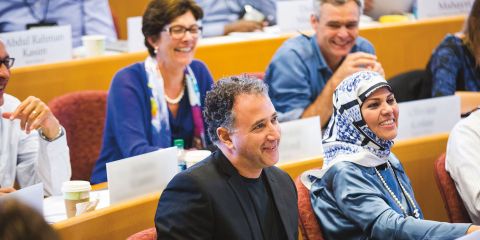Executives who attend our programs always praise the quality of teaching. While the content from each course—from the curriculum structure to the cases to the take-aways—is carefully designed, faculty also work hard to create a stellar classroom experience. So, how do they get ready to deliver an experience that engages everyone in the room in a powerful and memorable exploration of the topic, every time? Three Executive Education faculty members shared their secrets.
WHAT KEY STEPS DO YOU TAKE JUST BEFORE THE START OF A NEW PROGRAM SESSION?
John Beshears (JB) (faculty for Behavioral Economics—Virtual): All of the planned content is ready at that point, so I focus on how I can draw out the best possible "unplanned content"—those amazing participant-generated insights and discussions that I didn't foresee but that are memorable takeaways. I review participant profiles, asking myself whose voice would be interesting to hear on a given topic. I also try to consider the class content from a participant's perspective—if I were thinking about a given concept for the first time, what questions would I have? Of course, this preparation only takes me so far. The most important step is to remind myself that I should walk into the classroom with my plan but also be open to going where the discussion takes us.
Alison Wood Brooks (AB) (faculty for Developing Yourself as a Leader—Virtual, Communicating for Impact—Virtual): Even before a program begins, I ask participants to respond to a poll. The poll asks what their strengths and weaknesses are, their biggest communication challenges at work and outside of work, and why they've enrolled in the program. The responses are always exceptionally enlightening, providing a snapshot of this moment in their work and life that helps me understand and—I hope—enables me to better accommodate their expectations, aspirations, and unique areas of concern and opportunity.
WITH THE BUSINESS WORLD ALWAYS CHANGING, HOW DO YOU ENSURE THAT THE LECTURES AND DISCUSSIONS REMAIN RELEVANT?
Ayelet Israeli (AI) (faculty for Agribusiness Seminar, Managing Sales Teams and Distribution Channel, Leading in the Digital Era): I always make sure to stay in touch with practitioners and leaders, read trade magazines, news, and journals, and continue to be informed of what's going on in the world. The nice thing about the case method approach is that the professor doesn’t have to be the expert in every single topic or trend—we need to be able to facilitate the discussion and the learning presented by the case. The classroom itself is another great source of knowledge—and the faculty also learn a lot from the students about what's new in their business and what trends they are seeing.
JB: I keep in touch with past program participants, who are a wonderful resource for helping me keep track of trends. They know the frameworks from the program they attended, and they can provide insight on where the frameworks are working well and where the frameworks need to evolve based on the current state of business. I love hearing how they use ideas from our program in their organizations. Their stories are great examples that I can then bring up in future program sessions. In fact, the challenges they face might even become new HBS case studies.
AB: I teach about the psychology of conversation, especially the fundamental building blocks of communication that transcend context—skills and insights that apply across people, purposes, languages, cultures, and so on. In some sense, this is foundational human behavior that doesn't change with the times. But the context in which people need to apply these skills does indeed change. I try to keep my finger on the pulse of the challenges people are likely to encounter as they apply conversation skills in diverse contexts, especially in the ever-evolving digital age. We often invite visitors or guest instructors who specialize in digital communication, meeting management, crisis communication, or levity (a particularly context-specific skill) to address the participants' context-specific needs.
HOW DO YOU ORGANIZE A PROGRAM—OR EVEN A SINGLE LECTURE—TO ALIGN WITH THE PARTICULAR DEMOGRAPHICS OF A PARTICIPANT GROUP?
AB: Though the communication skills I teach apply to all demographics, I like to think ahead about what the participants in the room might find easy or challenging in their work and lives. We often discuss the roadblocks that stand in the way of successful communication, and the specific roadblocks will differ depending on who is in the room. These differences are important to uncover and work through together. Even when no clear solution or consensus exists, it is empowering for participants to think through these problems together with other smart, supportive folks experiencing similar things.
AI: One of my favorite things about HBS is the diversity in the classroom, the respect for others' opinions, and the inclusion of everyone in the discussion. By using true stories, the case method engages participants in debating the main issues of the case. Together, participants expand their knowledge, challenge each other and themselves, come to understand others' viewpoints, and arrive as a group at better insights and conclusions. Part of the point of this approach is to get outside of your comfort zone, deal with ambiguity, and learn from diverse opinions and worldviews. Rather than customizing the program for the group, I am leveraging the demographics of the group to enhance the learning. Customization happens when I tailor a program around which topics the group finds most interesting. I also will teach a case differently in different programs, emphasizing specific learning points for the purpose of a given program’s goals.
HOW DO YOU APPLY PARTICIPANT FEEDBACK TO THE NEXT SESSION OF A PROGRAM?
AB: My co-instructors and I are always on the lookout for ways to improve our programs and sessions. Feedback from participants often triggers ideas and connections that prompt me to add new examples, cases, or exercises—and to subtract and simplify when things have seemed to move too quickly, especially over important topics. Much of my research focuses on how to manage topics in conversation—how quickly or slowly to move from one idea to the next. That challenge applies in all conversations, including our classroom discussions with Executive Education participants. And, of course, positive feedback from participants helps to inspire instructors like me to keep going.








